#Gabriel Chávez
Photo

The Scapular (1968, Mexico)
Also known by its original title, El escapulario, Servando González’s The Scapular is one of the finest examples of classic Mexican horror filmmaking. For those versed in modern horror, adjust your expectations. Atmospheric from its opening moments and making full use of its sparse environments, this movie does not depend on bloody set pieces or instant frights. Instead, The Scapular prefers gradual storytelling through flashbacks, all while it refuses to answer how any of its unlikely events might be possible. The screenplay by González, Jorge Durán Chávez, and Rafael García Travesi navigates questions of Catholic faith, political preferences during the Mexican Revolution (1910-1920), and love amid more grotesque moments one comes to expect in a horror film. Those horror elements – of spirits staying true to their word – are most prominent at the very beginning and second half of the film, and absent for almost all the first half. A major contribution from cinematographer Gabriel Figueroa – regarded by some to be the greatest Mexican cinematographer of all time – and his Hollywood-influenced lighting elevates the movie, bathing the screen in intoxicating black-and-white.
Something during or after the Mexican Revolution, Father Andrés (Enrique Aguilar) pulls into town on a late train, following an unseen individual to the residence of Doña María (Ofelia Guilmáin). While the padre and the unseen person – the camera nods “yes” in response to a few questions from the padre – amble through town, two bandits follow close behind. They have been stalking Father Andrés since he disembarked the train, hoping to pilfer his gold watch. They decide to wait until after he administers his sacraments to Doña María. Inside, Doña María – whom the padre knows almost nothing about – hands the padre a scapular (a primarily Catholic garment of piety), which she claims to have saved the lives of her two eldest sons. El escapulario, for most of its remaining runtime, flashes back to the stories of those two sons, Julián (Carlos Cardán) and Pedro (Enrique Lizalde).
Once a soldier for the Mexican government, Julián defects and joins the rebels in their fight against Porfirio Díaz’s dictatorship. For Pedro, he is working for his uncle at a saddle shop, but has his eyes on the village chief’s niece, Rosario (Alicia Bonet) – in his attraction, class tensions come to a head.
Servando González, Jorge Durán Chávez, and Rafael García Travesi’s screenplay does the best it can with an unwieldy story structure. Though El escapulario is a breezy eighty-five minutes, the flashbacks for Julián and Pedro both feel slightly too long while the audience is itching for a macabre payoff. Nevertheless, the screenplay juggles numerous themes without ever feeling forced. Discussion about the Mexican Revolution is mostly confined to Julián’s story. At times, the dialectic between Mexico’s then-contemporary military dictatorship and peasant-led revolution sounds too much like propaganda. But given that Doña María is responsible for imparting this story to the padre (and, by extension, the audience), one can expect some over-romanticizing the revolutionary cause. El escapulario firmly sympathizes with the revolutionaries – following how popular historical memory is in Mexico today. In Julián’s story, this ideological conflict takes place entirely within a military and revolutionary backdrop. Civilian perspectives are not present for this part, but there are mentions of a groundswell of support for the revolutionaries. Acknowledging these partisan emotions and political interpretations, viewers who have not seen the entirety of The Scapular should accept the bare facts of Doña María’s recounting of Julián and Pedro’s stories as truthful – even though she was not present for any of the moments she describes. To say more risks spoiling the entire film.
Pedro’s chapter of El escapulario is less explicitly political than his elder brother’s, but related tensions persist. Pedro, firmly in the working class but not poor, inspires the wrath of Don Augustín (Jorge Russek, who played Major Zamorra in 1969’s The Wild Bunch) by even looking longingly at his niece, Rosario. Don Augustín is no moustache-twirling villain, but his disregard for his fellow villagers and overinflated opinion of himself make clear his sympathies for the Porfiristas against the revolutionaries and peasantry. Director Servando González keeps the focus on the brothers in both flashbacks, rooting the film through the perceptions of those with little to benefit under the Porfirio Díaz regime. It is in Pedro’s story that the first bits of horror filmmaking appear since the film’s opening minutes. Occult, perhaps darkly religious, forces influence developments as Pedro disregards Don Augustín’s advice to avert his wandering glance from his niece. These moments hinge on the scapular, as Don Augustín enlists others to intimidate – by force, if necessary – Pedro and Rosario from even thinking about each other.
In those moments, cinematographer Gabriel Figueroa’s work truly shines. Figueroa, who, in 1935, lived in the United States for a year to formally study his craft under Gregg Toland (1940’s The Grapes of Wrath, 1941’s Citizen Kane), certainly learned much from the man he considered his teacher. Even after returning home to Mexico in 1936, Figueroa continued to analyze Toland’s work closely – from chiaroscuro techniques to deep focus cinematography. But even before leaving for America, Figueroa’s work as a still photographer exemplified someone with a keen eye for composition. And long after his time under Toland, Figueroa would shadow some of Hollywood’s best cinematographers on his trips to Southern California; Toland himself, when visiting Mexico, would make suggestions and critique his old student’s work. Figueroa also enjoyed the privilege of friendships with Mexican artists Diego Rivera (who counseled him on how to use color – a story for another time, as El escapulario is a black-and-white film) and David Alfaro Siqueiros. Siqueiros provided Figueroa advice on escorzo or, in English, foreshortening. Foreshortening is an artistic technique on perspective that allows an artist to portray something that appears to be closer or shallower than it is.
Foreshortening becomes crucial in El escapulario’s second half, as the narrative descends in into the grisly and ghostly. A nocturnal horse ride during Pedro’s chapter stumbles upon a horrific sight, aided by foreshortening, sharp but still-horizontal angles, and quick cuts as the horse begins to buck wildly – spooked by unnatural forces that animals in movies just seem to pick up on faster than any human. The lighting’s influence on this scene’s mood is impossible to replicate if this was a color film. El escapulario’s final two scenes – by chicanery, candlelight, and cobwebs – are the culmination of what Gabriel Figueroa picked up from the likes of Toland and Siqueiros. Even when traversing an empty street at the witching hour or in a desolate room, there always seems to be a presence watching and waiting. Early morning mist appears to curl around the characters, like wispy hands. I am uncertain how this effect was achieved, and it might be seen as campy in most other contexts. Here, it is as if unknown forces are toying with the characters’ souls. It is spectacular camerawork from Figueroa, in his only collaboration with Servando González in a career spanning more than two hundred movies.
Viewers could also approach The Scapular from a religious context. The lines between life and death, faith and the absence of it, are tenuous. Catholicism and Catholic metaphysics are present from the prologue, impacting the dialogue and behaviors of all of the characters from their moments of introduction. Those more familiar with Catholicism in Mexico – the 2020 Mexican census says 77.7% of Mexicans practiced Roman Catholicism – can hopefully make more educated and nuanced contributions to religiously-inflected analyses of The Scapular than I possibly could.
The Golden Age of Mexican cinema, in some ways mirroring, but distinct from, a similar Golden Age for the nation’s northern neighbors, had been concluded for a decade when Servando González’s El escapulario premiered in theaters in 1968. Though some Mexican horror movies flourished before the end of that Golden Age, the films that fueled – and continue to inspire – Mexican horror cinema followed the footsteps of Fernando Méndez’s El vampiro (The Vampire; 1957), a late Golden Age film that broke through in a filmmaking and moviegoing environment heavy on melodramas and Westerns. The writing of this chapter of Mexican film history continues, still hampered by the 1982 Cineteca Nacional fire that destroyed several thousand Mexican films, screenplays, and books and an anecdotal domestic disinterest in Mexico’s cinematic heritage.
With thanks to the Academy Museum of Motion Pictures in Los Angeles and guest programmer Abraham Castillo Flores (also Head Programmer at Morbido Fest, based in Mexico City), the reclamation of that history is underway. Yours truly was able to see a restored print of El escapulario with complete English subtitles, although some audio hitches – especially in regards to the film’s score – remain. The technical mastery is apparent across El escapulario, and Servando González’s directorial vision and Gabriel Figueroa’s visual flourishes are worth the watch even for those unaccustomed to non-contemporary horror filmmaking. El escapulario is a visual treat, a chilling entry into the canon of classic Mexican horror.
My rating: 7.5/10
^ Based on my personal imdb rating. My interpretation of that ratings system can be found in the “Ratings system” page on my blog (as of July 1, 2020, tumblr is not permitting certain posts with links to appear on tag pages, so I cannot provide the URL).
For more of my reviews tagged “My Movie Odyssey”, check out the tag of the same name on my blog.
#El escapulario#The Scapular#Servando González#Enrique Lizalde#Enrique Aguilar#Carlos Cardán#Federico Falcón#Alicia Bonet#Ofelia Guilmáin#Eleazar García#Jorge Durán Chávez#Rafael García Travesi#Gabriel Figueroa#Gregg Toland#My Movie Odyssey
4 notes
·
View notes
Text
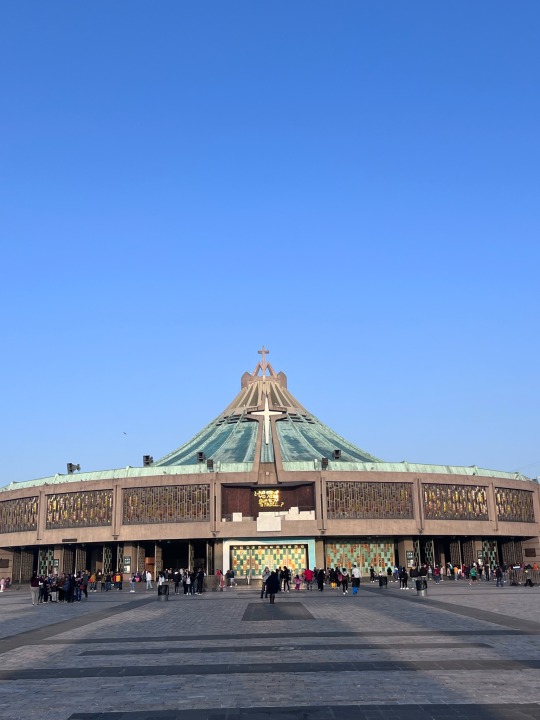
PEDRO RAMÍREZ VÁZQUEZ // CHÁVEZ DE LA MORA
Nueva Basílica de Santa María de Guadalupe, 1974-1976
1 note
·
View note
Text









Faceclaim dump:
Paulina Chávez ¦ Jaz Sinclair ¦ Aslıhan Malbora ¦ Greta Onieogou ¦ Maitreyi Ramakrishnan ¦ Beanie Feldstein ¦ Bruna Marquezine ¦ Chelsea Tavares ¦ Tati Gabrielle
#female writers#original writing#faceclaim#fanfic#wattpad#writing#fancast#face character#writers#gif pack
5 notes
·
View notes
Photo
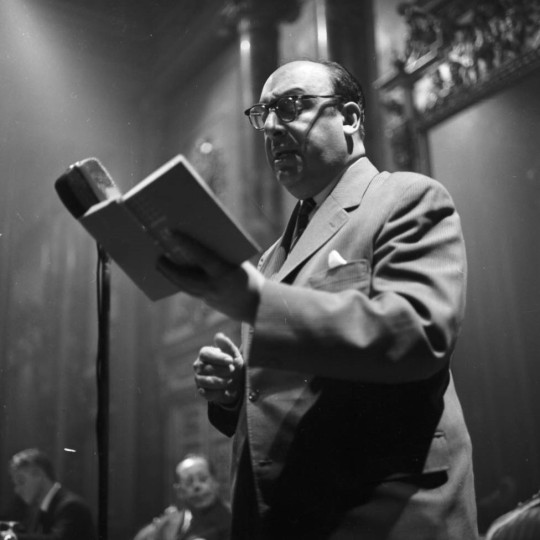
On 22 September 1973, Nobel laureate Pablo Neruda – whom Gabriel García Márquez dubbed "the greatest poet of the 20th century" – received some visitors at the Santa María hospital in Chile's capital Santiago. Among them were Sweden's ambassador Harald Edelstam and the Mexican ambassador Gonzalo Martínez Corbala, offering a plane to fly Neruda and his wife Matilde into exile.
We know about their conversation thanks to as yet unpublished documents at the National Archive in Sweden. Edelstam asserts he found the poet "very ill" though still willing to travel to Mexico. In a memo sent to his superiors, Edelstam observes: "In his last hours [Neruda] either didn't know or didn't recognise he suffered a terminal illness. He complained that rheumatism made it impossible to move his arms and legs. When we visited him, Neruda was preparing as best he could to travel … to Mexico. There, he would make a public declaration against the military regime."
That made the poet dangerous to some very powerful people, who had shown they would stop at nothing to defend their interests. They had ousted his friend, Salvador Allende, from the presidency less than a fortnight earlier. Allende died in a coup that was as much about silencing dissident voices as bringing about regime change. Another voice, that of popular singer Víctor Jara, was cut off four days later. Neruda remained. He was perhaps the loudest. His face certainly the most recognisable worldwide. He was too dangerous.
Members of the junta are on record expressing the view on the morning of September 22 that if Neruda flew into exile, his plane would fall into the sea. In the afternoon, radio stations under military control announced the poet would probably die in the next few hours, at a time when he was still awake in the hospital. The following day he was dead.
That historical mystery alone explains why his body was exhumed this week. But there are more pressing reasons too, at a time when the destiny of the left hangs in the balance in Latin America. The death of Venezuela's Hugo Chávez, one of many leftist leaders in the region to have fallen ill to cancer, has combined with the 700 documented assassination attempts against Cuba's Fidel Castro to fuel all manner of conspiracy theories.
More important still is the fact that, faced with an economic crisis without foreseeable end and few alternatives, a new generation of world activists needs to reconnect with the vibrant political imagination embodied by Neruda. The question is not merely whether the commitment he exemplified is possible now, but whether technology, and the institutions we use to manage it, can allow the kind of freedom Neruda called for in his poetry.
In this context, Neruda's life, as well as the shadows cast by his death, are Google-bombs waiting to be set off by a new generation of networked freedom fighters at the heart of our austerity-obsessed, repressive, and frankly boring narratives.
Neruda wasn't surprised by the 1973 coup – most people knew that the consequences of restoring "economic order" would be vicious, and many accepted it as necessary – but it wasn't inevitable: under a deal accepted by the government coalition as well as the opposition, President Allende was going to call for a referendum and would have resigned if the result went against him. This made any show of force by the smaller but influential sector within the Chilean armed forces unnecessary. But the conspirators were bent on regime change, so they brought forward the date of the coup, subjecting Chilean society to a trial by fire in order to cure it of a supposedly menacing communist "cancer".
The invocation of "cancer" to provide yesterday's rulers with a pretext to unleash war abroad and repression at home is mirrored by the questions being asked about Neruda's cancer today.
Neruda and the other individuals behind the Chilean revolution of the early 1970s made mistakes and were at least partially responsible for the consequences. But the real story behind their defeat and deaths hasn't been told yet. This is one of the reasons why people are looking to unearth new truths, hoping to shed some light on the origins of our problems today.
Through histories, testimonies, and documents declassified in the US or revealed as recently as last year by Wikileaks, we now know that the fate of Neruda and others like him had been decided long before they had any hand in mismanaging the economy or dividing political opinion. Persecution of the left had begun in Chile as early as 1948, at the behest of a US government awash with anti-communist paranoia.
That year, a controversial measure known as "the Damned Law" ("la ley maldita") outlawed the Chilean Communist Party, sent the communist leadership into exile and imprisoned hundreds of militants at the Pisagua camp under the orders of a young lieutenant named Augusto Pinochet – the concentration camp's director who would become Chile's dictator, and a friend and inspiration to Margaret Thatcher.
Neruda, radicalised like many others by the anti-fascist struggle of the 1930s and 40s, chose to flee the country. Fearing for his life he crossed the Andes on a horse, carrying with him the manuscript of his epic poem Canto General, before resurfacing in Mexico thanks to the help of his friends Pablo Picasso and Diego Rivera.
His second exile would have been in 1973. Edelstam's conversation with Neruda took place a mere two hours before the poet went to sleep, never to wake up again. When the Swedish diplomat went to Neruda's house to offer his condolences, he found it destroyed. Pinochet's men were bent on erasing every trace of his existence. They would do the same with thousands of people during a reign of terror that would last for nearly two decades. That is why so many people this week are holding their breath to find out what clues Neruda's exhumed body might hold.
One of the most enduring mysteries in modern Chilean history may finally have been solved after forensic experts determined that the Nobel prize-winning Chilean poet Pablo Neruda died after being poisoned with a powerful toxin, apparently confirming decades of suspicions that he was murdered.
According to the official version, Neruda – who made his name as a young poet with the collection Twenty Poems of Love and a Song of Despair – died from prostate cancer and malnutrition on 23 September 1973, just 12 days after the military coup that overthrew the democratically elected socialist government of his friend, President Salvador Allende.
But some, including Neruda’s nephew, Rodolfo Reyes, have long believed he was murdered because of his opposition to the then incipient dictatorship of Augusto Pinochet.
Ten years ago, a Chilean judge ordered the exhumation of the poet’s remains after his former chauffeur, Manuel Araya, revealed that an agitated Neruda had called him from the Santiago hospital where he was being treated to say that he had been injected in the stomach while asleep. The poet died hours later.
Samples of Neruda’s remains were dispatched to forensic laboratories in four countries for analysis, and in 2015 the Chilean government said it was “highly probable that a third party” was responsible for his death. Two years later, a team of international scientists said they were “100% convinced” the poet did not die from prostate cancer.
On Monday, Reyes said scientific tests had shown the toxin clostridium botulinum was present in his uncle’s body when he died, suggesting he was indeed “poisoned” in the aftermath of the coup. The results of expert analysis are due to be published in a report on Wednesday.
“We now know that there was no reason for the clostridium botulinum to have been there in his bones,” Reyes told the Spanish news agency Efe. “What does that mean? It means Neruda was murdered through the intervention of state agents in 1973.”
The bacteria, which produce the neurotoxin that causes botulism, were discovered on one of Neruda’s exhumed teeth in 2017. Reyes said analysis by experts at McMaster University in Canada and the University of Copenhagen had established the bacteria did not find their way into Neruda’s body from the coffin or the surrounding area.
“We’ve found the bullet that killed Neruda, and it was in his body,” Reyes told Efe. “Who fired it? We’ll find out soon, but there’s no doubt Neruda was killed through the direct intervention of a third party.”
Pinochet’s US-backed coup, during which Allende killed himself as troops stormed the presidential palace, devastated Neruda and led him to plan an exile in Mexico.
But a day before his planned departure, he was taken by ambulance to the hospital in the Chilean capital where he had been treated for cancer and other conditions. He died there on the evening of 23 September, purportedly from the wasting effects of the prostate cancer that had first been detected four years earlier.
However, the official version of the events surrounding his death has frequently been called into question. Gonzalo Martínez Corbalá, who was Mexico’s ambassador to Chile at the time of the coup, told the Associated Press he had seen Neruda two days before his death, and that the poet had weighed almost 100kg (15st 10lbs) – contradicting claims that he was fatally malnourished because of his cancer.
Last month, Araya told AP that if Neruda “hadn’t been left alone in the clinic, they wouldn’t have killed him”.
The chauffeur said he and Neruda’s wife, Matilde Urrutia, had been at the couple’s mansion to pick up their suitcases for Mexico when the poet rang, asking them to come back to the hospital quickly. Neruda died later the same day.
Following Neruda’s death Urrutia maintained that he had been increasingly agitated as he learned of the early atrocities of the dictatorship and that it was the anguish of the coup d’état which led to his demise.
The lengthy investigation hit a number of obstacles, from non-cooperation on the part of the clinic where the alleged injection was administered to difficulty in funding foreign lab tests.
In the years after Neruda’s death, much of the focus has been on locating a mysterious “Dr Price” who had apparently been on duty at the clinic that night. However, there was no mention of the doctor in the records of Chile’s medical union, and it was eventually deduced that he had been invented to stall investigations.
Though described by his friend Gabriel García Márquez as “the greatest poet of the 20th century in any language”, Neruda’s reputation has been damaged in recent years by details of his personal life. Not only was the writer a self-confessed rapist, he was also a man who abandoned his first wife and their daughter, Malva Marina, who was born with a neurological disorder and died at the age of nine.
In his posthumously published memoirs, Confieso Que He Vivido (I Confess That I Have Lived), Neruda admitted raping a Tamil woman who worked as his servant when he was posted to Ceylon as a young diplomat. After describing the rape, he wrote: “She was right to despise me.”
The rape confession, which resurfaced almost five years ago, led human rights activists to oppose an attempt to rename Santiago airport in honour of the poet.
Speaking at the time, the author and women’s rights campaigner Isabel Allende told the Guardian that Neruda’s criminal and callous behaviour did not devalue his work.
“I am disgusted by some aspects of Neruda’s life and personality,” she said. “However, we cannot dismiss his writing. Very few people – especially powerful or influential men – behave admirably. Unfortunately, Neruda was a flawed person, as we all are in one way or another.”
Daily inspiration. Discover more photos at http://justforbooks.tumblr.com
20 notes
·
View notes
Text
here we go since like 3 people liked my last post, here it is. my fancast for a live-action cw-style teen drama based on miraculous ladybug
Remember, everything is aged up a bit (16-19), everything is edgier and darker, and relationships are messier and more melodramatic.
first we have our leads:
Marinette Dupain Cheng is a sweetly quirky and artistic girl who is fueled by passion to achieve her ambitious goals despite her anxious nature, played by Devyn Nekoda, a lesser-known actress with a background in dance who has yet to truly find a breakout role.
Adrien Agreste is the disaffected heartthrob with Soft SadBoi Cinnamon Roll Vibes, a sense of sarcasm that he uses as a defense mechanism, and a subtle charisma, played by experienced actor Charlie Plummer.

Marinette's baker parents are played by Tom Welling and Kristin Kreuk who have the chemistry to make Thom and Sabine really cute.
Gabriel Agreste is played by Ioan Gruffudd who brings a charismatic intensity and intelligence to Gabriel. His enigmatic """"dead""" wife makes cameos in flashbacks played by Laura Vandervoort (alternative: Amanda Schull).
now for some shadier characters:

Cold, efficient, and obsessive Nathalie Sancoeur played by Bridget Regan
Strong and silent bodyguard and threat, The Gorilla played by Tyler Mane
Cutthroat backstabber Lila Rossi, played by Nicole Huff
Self-destructive, broken, and unhinged mean-girl, Chloe Bourgeois played by Savannah Kennick
Amiable-but-spineless slimeball, Mayor Andre Bourgeois played by Clark Gregg
Ruthless Fashionista Audrey Bourgeois played by Rebecca Romijn (alt. Madchen Amick)

Eccentric hipster and outsider Luka Couffaine - Wyatt Oleff (alt. Asher Angel)
Stoic but still kind, Kagami Tsurugi - Lisa Yamada
Bold, vivacious, and inquisitive, Alya Césaire - Paulina Chávez
Friendly, loyal, and effortlessly cool, Nino Lahiffe - Coy Stewart
Anxious and quiet goth girl, Juleka Couffaine - Makenzie Foy (alt. Lola Flanery)
Girly-girl, punk, and sweetheart, Rose Lavillant - Grace Vanderwaal
Math nerd and loveable dork, Max Kante - Jahbril Cook
Precious little hippy friend Mylene - Madison Bailey (alt. Layla DeLeon Hayes)
Snarky skater girl, Alix - Erin Pitt
Easy going sports bro Kim - Lance Lim
Wannabe cool girl, half-sister Zabrina Lee - Ella Anderson (alt. Chloe Csgenery)
Quiet Austitic Kid Ivan - Aedin Mincks
playlist:
#ml fancast#miraculous ladybug#mlb#adrien agreste#marinette dupain cheng#Spotify#marichat#adrienette#ladynoir#ladrien#ml lovesquare
27 notes
·
View notes
Video
vimeo
El desayuno (Film, short version) - Miguel Casco from Miguel Ángel Casco on Vimeo.
Largometraje / Performance / Videoarte
Miguel Casco en colaboración con Hekatombe Producción Artística
Catorce personas habitan su propia piel para atestiguar el amanecer y compartir sus cuerpxs mientras el sol naciente ilumina el espacio. La interacción se suscita entre ellxs y la premisa principal es celebrar la vida, honrar la libertad y el disfrute. El Desayuno invita a abrazar la desnudez y entrar en sintonía con la naturaleza.
miguelcasco.com
D I R E C C I Ó N
Miguel Casco
D I R E C C I Ó N E S C É N I C A
Andrea Garay
D I R E C C I Ó N C O R E O G R Á F I C A
Sebastián Santamaría
D I R E C C I Ó N E J E C U T I V A
Catalina Navarrete
R E P A R T O
Mar Castañedo
Mónica Colin
Marlene Coronel
Mariana Domenech
Jimena González
Aileen Kent
Carlos Nunez
José Francisco Ordóñez
Luis Ortega
José Ortiz
Baruk Serna
V I D E O
Alan Espinosa
Erik Jonguitud
Michel Trevilla
F O T O G R A F Í A
Alejandra Edwards
David Flores Rubio
M Ú S I C A
Sebastián Lechuga (Intro, Oscuridad, Ofrenda y Desayuno)
Alejandro Preisser (Locura, Descenso, Claridad y Outro)
E D I C I Ó N D E V I D E O
Miguel Casco
Erik Jonguitud
D I S E Ñ O F L O R A L
Alejandra Velasco
M U S I C A L I Z A C I Ó N E N V I V O
Jail Less
E Q U I P O T É C N I C O
Humberto C. Cáceres
Heber Leonidez
Elena Manero
Ehécatl Moreno
María Naidich
Alfonso Pérez
Yair Ramírez
P R O Y E C T O R E A L I Z A D O C O N E L A P O Y O D E
Etna M. Arroyo, Jacobo M. Casco, Patricia Almada, Luis Antonio Garay, Elsa Hernández, Carlos Navarrete, Rocio Barajas, Carlos Santamaría, José María Macías, Andrés Castañeda, César Meza, Enrique Ajuria, Susana Tovar, Valeria Casco, Luis Antonio Casco, Heleni Castro, Óliver Victoria, Andrea Ayala, Andrea Anderson, Indira Zamora, Roberto González, Andrés Piña, Rafael Hernández, David C. Parra, Youtaek Hwang, Eduardo Palacio, Remi Cárdenas, Rogelio Toledo, Ross Romero, Isabella de la Mora, Tabaré Arroyo, Yair Ramírez, Luis Almada, Omar Cobos, Silvana Larrea, Raffaela Schiavon, Isabel Vieitez, Rebeca Zequera, Leonardo Galicia, Mark Feldmann, Francisco Saldívar, José Francisco Ordóñez, Neil Haidorfer, Bárbara Huerta, Adriana Degetau, Tere Sáenz, Chloe Estes, Fernando Almazán, Gina Guzmán, Mariano Nava, Rubén Ojeda, Diego Ortiz, Santi San Martin, Carlos Santamaría Barajas, José Funcia, Malimna Etnegorozka, Pablo P. Caro, Gabriela Chávez, Gabriel Picazo, Rubén Torres, Roberto Praxedis, Luis Pérez, Jeannette Betancourt, Elena Manero, Ma. Ceci Cuesta, Humberto Schiavon, Celeste Bejarano, Mario Montes & David Martínez.
14 notes
·
View notes
Text
Σημείο
Είναι υπέροχο να έχεις φτάσει στο σημείο
που δεν είναι πια αναγκαίο να ψάχνεις για τον σκοπό της ζωής σου
την αγάπη της ζωής σου
τον βορρά (και τον νότο) της ζωής σου
γιατί τα έχεις βρει ήδη όλα αυτά
�� σε έχουν βρει εκείνα
και τώρα τα φωνάζεις, σχεδόν με οικειότητα,
με ένα ουσιαστικό,
ίσως ένα όνομα
—εδώ μπορείς να βάλεις όποιο θέλεις—
ή κάτι μυστηριώδες, όπως η ποίηση.
Όμως, το πραγματικό θαύμα
είναι ότι πρέπει να συνεχίσεις να ψάχνεις,
να ψάχνεις
γιατί όλα τα πράγματα και όλα τα όντα
που βρίσκονται
έτσι όπως έρχονται φεύγουν κιόλας.
Ακόμα και η ποίηση μερικές φορές.
Αυτή η άγνωστη.
Gabriel Chávez Casazola
14 notes
·
View notes
Text
Martenochtitlan: hacia una ciudad del futuro

Es un taller lúdico colaborativo que se llevó a cabo en el museo Anahuacalli los domingos del 4 de septiembre al 9 de octubre del 2022. Fue impartido por el arquitecto Gabriel Benítez y la curadora Marcela Chao con la asesoría científica del astrofísico Juan Claudio Toledo.
El taller contó con la participación de Santiago Carassele, Fermín Chávez, Mariana Cruz, Ethan Galicia, Liliana Martínez, Raúl Santos y José Pablo Vázquez.
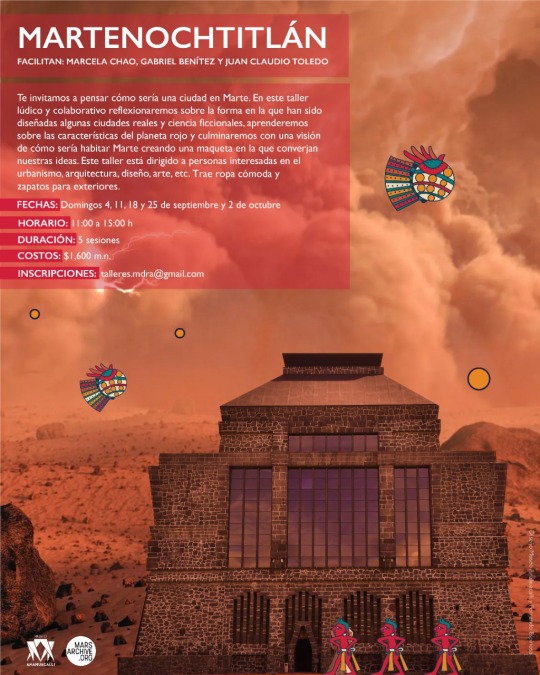
2 notes
·
View notes
Text
Guerrerense conquista tres medallas en el World Para Athletics Grand Prix 2024

CHILPANCINGO * Abril 8, 2024.
) Gobierno de Guerrero
En su participación dentro del World Para Athletics Grand Prix 2024, el lanzador

Guerrerense Marco Antonio Cortez Molina cumplió su objetivo y conquistó tres medallas, una de oro, una plata y una de broce.
El integrante del Club del Deporte Adaptado Avispones Chilpancingo, obtuvo la presea de oro en lanzamiento de jabalina F56 superando su marca personal con 20.29 mts con lo que obtuvo su primer metal dorado, en su primer evento internacional del año.
Mientras que el primer día de actividades se subió al podio tras obtener la medalla de plata en la modalidad de impulso de bala F56 con una marca de 7.70 mts rompiendo su marca personal.
Así también, en la segunda jornada de actividades logra medalla de bronce en lanzamiento de disco F56 y supera su marca personal con 30.16 mts.
Con estos resultados, el para atleta de 18 años de edad y vecino de la colonia Villa Moderna de Chilpancingo, se mete en el proceso rumbo a los juegos Olímpicos los Ángeles 2028.
Estos logros representan el empeño y dedicación de su equipo deportivo encabezado por el entrenador Diego Reyna Cortez, los Auxiliares: Jhons Iván Nava Juárez y Alexis Santos Chávez, el Fisioterapeuta: Jesús Gabriel Bailón Bello.
Con este evento, los guerrerenses concluyen su participación en el Xalapa 2024, World Para Athletics Grand Prix con grandes resultados, sumando cuatro metales para México, una presea de oro, dos medallas de plata y una de bronce.
) facebook.com/acapress.mx
) facebook.com/angelblanco.press
) facebook.com/groups/mexicosur.news
) facebook.com/groups/AcapulcoNoticias
) acapulcopress.com
Read the full article
0 notes
Text
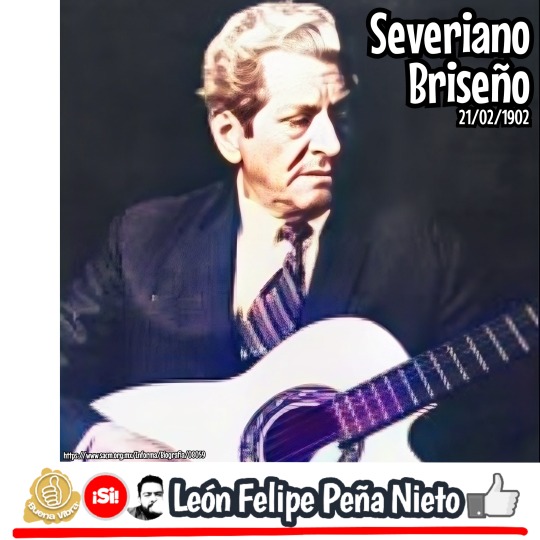
🍀¡Hola familia!. Un día como hoy, 21 de febrero, pero del año 1927, en San José de Canoas, San Luis Potosí, México🇲🇽, nació el Músico🎻, Compositor🎼 y Cantante🎙️: "Severiano Briseño". Severiano Briseño Chávez. Un poeta de la canción huasteca. Fue Socio Fundador de la Sociedad de Autores y Compositores de México, SACM. Con los hermanos Rafael y Guillermo Samperio, formó el Trío "Los Huastecos", con ellos compuso, cuando andaban por Sinaloa, "El Sinaloense". ¿Quién no conoce esa canción?. Posteriormente, sus canciones musicalizaron películas de Cine 🎥🎬 y fueron interpretadas por cantantes tales como: Lola Beltrán, Piporro, Charro Avitia, Luis Aguilar, Juan Gabriel, y Lucha Reyes, entre otros. Todo un fuera de serie. Nombrado por la comunidad empresarial regiomontana como: "Hijo predilecto de Monterrey".
#SeverianoBriseño
#ElijoSerPositivo
#LeónFelipePeñaNieto
Te invito a conocerle
Mira aquí, súbele 👇
Recomiendo usar 🎧
-El Sinaloense- con Luis Aguilar 🎶 "- 🎥🎬
https://youtu.be/YgRouxaZFL8?si=BHqbbokfxeT7tSED
0 notes
Text
La emoción está en el aire, y los reflectores se encienden para destacar a los deportistas que han brillado a lo largo del año. La Fiesta del Deporte 2023 está a punto de comenzar, y con ella, se revelarán los nombres de los atletas que han dejado una marca imborrable en sus respectivas disciplinas. ¡Acompáñanos en esta celebración deportiva única!
Un Reconocimiento Especial
Como cada año, la Fiesta del Deporte rompe con la tradición al no elegir un ganador único por categoría. En cambio, cada deportista nominado recibirá una mención especial por su destacada actuación. Además, se otorgarán reconocimientos a la trayectoria, a la revelación del año y al Deportista del Año, un título codiciado que corona al máximo exponente del mundo deportivo.
Detalles del Evento
La cita es este miércoles, desde las 20:30, en el Anfiteatro “Alfredo Williner”, se realizará la Fiesta del Deporte y Elección del Deportista del Año 2023 de Rafaela.
El evento es resultado del incansable trabajo de la Subsecretaría de Deportes y Recreación, en colaboración con diversas áreas, que se han esmerado en cada detalle para garantizar una velada inolvidable.
Nominaciones Destacadas por Disciplina
DEPORTISTAS DESTACADOS POR DISCIPLINA
AEROMODELISMO
MARIO PALMIERI
RICARDO PALMIERI
ENRIQUE LEVRINO - LEONARDO BARUCHELLI (EQUIPO F2C)
AJEDREZ
FELIPE DEL ZOPPO ROCCHETTI
SALVADOR DELGADO
PABLO FERREYRA
ATLETISMO
SANTIAGO DAPERNO
JOAQUÍN CARBALLO
LEONELA LÓPEZ
SOFÍA FREGONA
AUTOMODELISMO
JOSÉ FERNANDO FOTI
JUAN FRANCISCO KILGELMANN
AUTOMOVILISMO NACIONAL
CRISTIAN VAIRA
RICARDO SARACO
JOSÉ COSTAMAGNA
AUTOMOVILISMO ZONAL
AGUSTÍN GHIOTTI
NICOLÁS GONZÁLEZ
ALEJANDRO CIPOLAT
BÁSQUET
GINO JESÚS GRAMAGLIA
AGUSTÍN RÍOS
DANTE BENINCA
ANGELINA TOANI
BILLAR
PABLO PAGANI
BOCHAS
MARTÍN OVIEDO
LUCIANO CORREA
ANÍBAL RODRÍGUEZ
LUIS VALIENTE
BOXEO
YOANA RODRÍGUEZ
FABRICIO SPÓSITO
DAIANA DÍAZ
CICLISMO
FRANCO GABRIEL PONS
LUCAS LUIS PERETTI
JOSEFINA ECHANIZ
FISICOCULTURISMO
MARIANELA JESICA ASTRADA
ERIC ARNOLDT
DARÍO PINCIROLI
DIEGO FONTANETTO
FÚTBOL
CAMILA JUÁREZ
JUAN JOSÉ WEINSSEN
MANUEL BUSTOS
DANIEL FERNANDO ITURRIA
OSCAR MALDONADO
GIMNASIA ARTÍSTICA
ARACELI BURGOS
LUISINA LÓPEZ
JULIETA MENSEGUEZ
GOLF
LUCÍA BOCCHETTO
FEDERICO TORRESAGASTI
GIOVANNI CABAÑA
HANDBALL
LUISINA RODRÍGUEZ
LAUTARO ELÍAS SASSETTI
JOAQUÍN ACOSTA
HOCKEY
GUILLERMINA ASTUDILLO
FLORENCIA CORVALÁN
ALDANA PINTOS
MORENA HERNÁNDEZ
INTERCOLEGIALES
MAGALI ALLASSIA
JULIETA BRODA
NARELA PAZ
JULIA LAMBERT
VALENTINA MERLINO
FEDERICO DALMASO
JIU-JITSU
ALAN STRADA
GINO AGRANO
JOSÉ PRAI
KARATE
OLIDEN QUIRÓZ
AXEL NAVARRO
NICOLÁS ECHEVARRÍA
TIZIANO OESQUER
MIDGET
EUGENIO MAUTINO
GONZALO ZBRUN
TOMÁS PLATINI
MMA
FRANCO TEVEZ
JUAN CRUZ RAMALLO
SERGIO LUQUE
IGNACIO CASTIGLIONI
MOUNTAIN BIKE
GABRIEL DURANDO
RAÚL DURANDO
NORBERTO WILLINER
DIEGO DRUBICH
MOTOCICLISMO
EMANUEL ZAMORA
AGUSTÍN DONATI
VALENTINO CHIABOTTO
NATACIÓN
MARTINA GARCÍA
LOURDES ALIPRANDI
PABLO CÉSAR SCOZZINA
ANDRÉS DONNET
MIRANDA CÁCERES
PADDLE
FABRIZIO ALEJANDRO GARCÍA
VALENTINO MINETTI
NICOLÁS TELL
PATÍN
IRINA GUTIÉRREZ
DELFINA PERALTA
INDRA GADLER
SOFÍA ZOJA
PEDESTRISMO
MATEO QUIROGA
AGUSTÍN PECANTET
RODRIGO VISCONTI
GERMÁN FERNÁNDEZ
PELOTA PALETA
SANTIAGO BISANG
MATEO MONTOYA
LUIS MARÍA ZANONI
CRISTIAN EMMERT
RUGBY
GONZALO CLEMENZ
VALENTINO FERRERO
MARIANO FERRERO
RURAL BIKE
GABRIEL SCHMIT
LUISINA SIMONDI
CAROLINA ANTELLO
MARCELO GILLI
SALTOS HÍPICOS
EMILIA GAGLIANO
VÍCTOR MANUEL RICO
LILEN GIACOBONE
TAEKWONDO
BRENDA VALLEJOS
TIAGO ICASURIAGA
JEREMÍAS SOMMER
ARIEL ROLDÁN
TENIS
MATÍAS ALESSANDRIA
JOAQUÍN ESCOBAR
JOSEFINA ZIMMERMANN
TIRO CON ARCO
LUCAS HÉCTOR VÁZQUEZ
GERVASIO MOLINARO
MATEO LLODRA
TIRO DEPORTIVO
CLAUDIO ROMITELLI
PABLO ROBERTO FRANZETTI
LAUTARO SAMBRINI
TRIATLÓN
VIRGINIA MILANESIO
FLORENCIA GIRO
VOLEY
MILAGROS LOURDES MESA
SOFÍA SCHILLING
ANA GAIDO
JOAQUÍN BURQUET
VUELO A VELA
MIGUEL ÁNGEL SERRANO
MARCOS MEROÑO
GERMÁN RUBIN
WUSHU
LARA CHÁVEZ
VIOLETA MATTIO
LARISSA AMHERD
FRANCO AGUILAR
> PREMIOS ESPECIALES
DEPORTISTAS DE ALTO RENDIMIENTO
TOMÁS MONDINO - ATLETISMO
PEDRO EMMERT - ATLETISMO
ABRIL OKON - ATLETISMO
JUAN IGNACIO CANELA - AUTOMOVILISMO
DELFINA GENTINETTA - BÁSQUET
MELISA GRETTER - BÁSQUET
ROBERTO ACUÑA BÁSQUET
CANDELA GENTINETTA - BÁSQUET
OMAR SERRANO - BOCHAS
VÍCTOR EXNER - BOXEO
NICOLÁS BLANCO - BOXEO
OMAR DÍAZ - BOXEO
NATALIA VERA - CICLISMO
ÁNGELO MARTINO - FÚTBOL
LUCAS BLONDEL - FÚTBOL
FACUNDO COLIDIO FÚTBOL
FACUNDO LENCIONI - FÚTBOL
TOMÁS POCHETINO - FÚTBOL
SEBASTIAN ACUÑA - FÚTBOL
LUCÍA GONZÁLEZ - GIMNASIA ARTÍSTICA
EMILIA ACOSTA - GIMNASIA ARTÍSTICA
GUSTAVO ACOSTA - GOLF
PEDRO RUBIOLO - RUGBY
MAYCO VIVAS - RUGBY
GERMÁN ROMITELLI - TIRO
SUSANA HAUSWIRTH - TRIATLÓN
CATALINA INGARAMO - TRIATLÓN
SERGIO PERETTI - TRIATLÓN
> PREMIOS ESPECIALES
EX DEPORTISTA
WALTER PALMIERI
> PREMIOS ESPECIALES
AUXILIAR DEPORTIVO
GISELA TRUCCO
Con esta propuesta, se busca destacar la emoción del evento, presentar a los nominados de manera llamativa y agradecer a la audiencia por su apoyo, manteniendo un tono activo y directo.
https://rafaeladigital.com/noticias/la-fiesta-del-deporte-2023-celebrando-los-logros-de-nuestros-atletas/?feed_id=4332
0 notes
Text
#BasílicadeGuadalupe llamada oficialmente "Insigne y Nacional Basílica de Santa María de Guadalupe".⛪⛪🇲🇽🇲🇽
Recinto más visitado del mundo superado por la #Basilica de San Pedro.⛪⛪
Conformado por varias iglesias y edificios como🤔🤔
-Capilla de los Indios.
-Capilla del Cerrito.
-Panteón del Tepeyac.
-Capilla del Pocito.
-Templo y Antiguo Convento de las Capuchinas.
-Instalaciones para investigación.
-Museo de Basílica de Guadalupe.
-Templo Expiatorio a Cristo Rey, #AntiguaBasílicadeGuadalupe.
- #Nueva Basílica de Guadalupe.
La #Nueva Basílica fue construida para albergar a la imagen de la #Virgen de Guadalupe y #permitir el acceso a la mayor cantidad de pelegrinos.
Fue diseñada por los #arquitectos
*José Luis Benlliure.
* Pedro Ramírez Vázquez.
*Alejandro Schoenhofer.
*#Fray Gabriel Chávez de la Mora.
*Antonio S Gómez Palacio.
* Javier García Lascuráin.
#visitamexico 🚐🇲🇽🚶♂️con Transportacion y servicios turísticos Gascontour's.
#Información al 📲📲+ 525621618764 / +525537143400.
Untitled
View On WordPress
0 notes
Video
vimeo
Apple Arcade - A New World To Play In from Mauro Chiarello on Vimeo.
Director: Ian Pons Jewell
Producer: Chris Avery @ Apple
Writer: Jordan Pories
Creative Director: Hamish Pinnel
Art Director: Esteban Cardona
Group Creative Directors: Sam Oliver & Carl Broadhurst
AD Producer: Jacob Stitzel
Production Company: Reset
Managing Director: Dave Morrison
Executive Producers: Deannie O'Neil & Jen Beitler
Head of Production: JP Colombo
Producer: Megan Moore
Director of Photography: Mauro Chiarello
Director’s Assistant: George Daniell
Casting: Majo Gallardo
Costume Designer: Nayeli de Alba
Production Service Company: The Lift
Producer: Fuad Abded
Managing Director: Avelino Rodriguez
Production Manger: Israel González Cadena
Unit Manager: Vladimir Espinoza
Production Coordinator: Liliana Huacuja
APOC: David Carretero
Script: Andrea Eduardina
Key PA: Juan Tovar
Production Assistants: Erick Ávila, Miguel Luna, Isaac Alvarez
Runner: Paulina Camacho
Chaperone: Paulina Marín
Chaperone: Paulina Maqueda
Locations Manager: Sergio Aguilar
Locations Assistants: Itzia Rojas, Rodrigo López, Eduardo Gutierrez, Andrés Macías, Juan Chávez
1st AD DGA: Robert Phillips
1st AD: Sandra Mayerstein
2nd AD Vala Cárdenas
2nd AD: Lorenza Ramos
1st AC Horacio Vega
2nd AC: Adonay Meza
Camera PA: Edson Reyes
DIT: Julio Cesar Gonzalez
Data Manager: Hayde Medina Corona
VTR Operator: Jonathan Fernando Noriega Hernández
VTR Assistants: Eduardo Martinez & Miguel Valdez
Wheels Operator: Felipe Pérez-Burchard
Steadicam Operator: Gerardo Manjarezz
Trinity Operator: Niels Lindelien
Gaffer: Leonardo Julián
Key Grip: Juan Antonio Aguilar López
Key Grip: Jose Marcos Vilchis
VFX Supervisor: Daniel "Chovy" Cordero
VFX Assistants: Rafael Santana Cruz & Francisco Ruben Perez Reyes
Production Designers: Robin Brown & Margarita Laborde
Hair & Make Up: Chela Olea
Hair & Make Up Assistants: Yoali Cortés, Ixchel Cortés
Stunt Coordinator: Tomas Guzman
Art Coordinator: Katia Duarte
Propmaster: Diego Téllez
Decorator: Melinda Ridaura
Decorator: Sandra Jalife
Art Assistant: Jessica Peralta
Wardrobe Coordinator: Giselle Arriaga
Wardrobe Assistants: Rodrigo Montoya, Paulina Regalado, Christian Fernando, Rocelia Alexandra
Graphic Design: Mireya Guerrero
Renders: Hugo Jiménez
Swings: Daniel Hernández, Jesús Enriquez, Aldo Márquez, Juan Cisneros, Néstor Luna, Luis Hernández, Gabriel Cabrera.
Edit Company: Whitehouse Post, Los Angeles
Editor: Tobias Suhm
Executive Producer: Joanna Manning
Post Producer: Jordan Stricklin
VFX Company: Framestore
VFX Supervisor: James Rogers
Senior Producer: Joe Greenberg
Art Director: Carlos Vidal
Lead Data Wrangler: Fabio Zapata
Data Wrangler: Juan Colon
Coordinator: Evan Kanter
CAST
Kid in car: Ariella Covalin-Mizarahi
Metro Guy: Shu Sakimoto
Chef & Waiters:
Jack Morris
Jean Wolf
Allison Vargas
Taco Stand:
Mariana Arias
Emme Gonzalez
Paulina Camacho
Oscar Sagrado
Raphael De Cecco
Ivan Modragon
Christian Godoy
Miguel Angel
Airplane: Heidy Diaz
Popcorn Eaters:
Micah Bijon
Charlie Scovill
Clothes Guy: Rick Darge
Bus Shelter: Yuki Oc-Noda
0 notes
Text
Entre los dos cielos — Gabriel Chávez Casazola
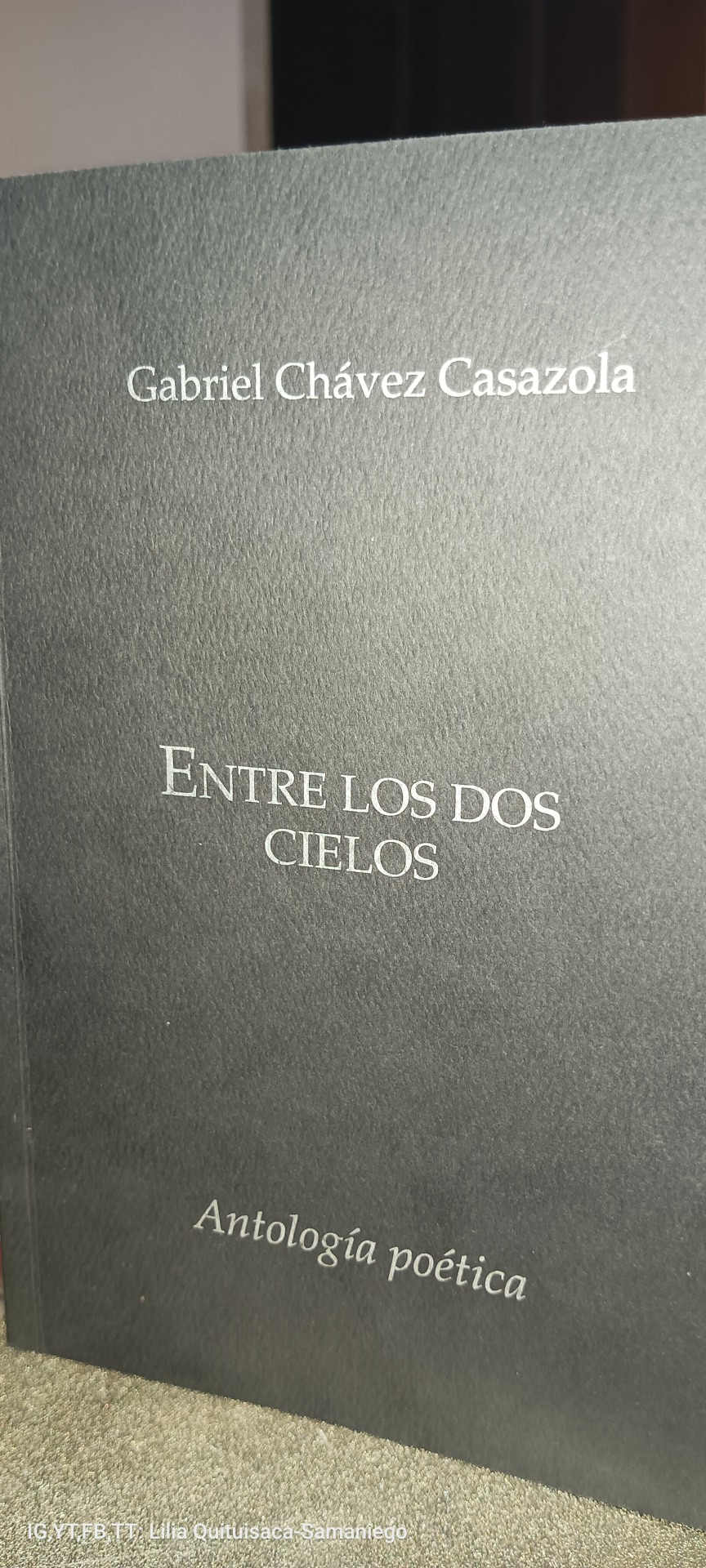
View On WordPress
1 note
·
View note
Text
@𝗡𝗼𝘁𝗶𝗛𝗮𝘁𝗶𝗹𝗹𝗼
El Hatillo, 28 de Agosto del 2023
Buenos días, nuestro resumen diario de noticias llega a ustedes gracias a @NotiHatillo /Alcaldía de @ElHatillo /Redes Sociales
TITULARES
MUNICIPALES
- Via redes sociales, las fallas eléctricas siguen afectando al municipio El Hatillo, cuadrillas de CORPOELEC trabajan sin descanso para solventar esta situación, Caicaguana se mantuvo más de 50 horas sin servicio eléctrico hasta que anoche fue restituido plenamente, hoy varias calles y avenidas de la urbanización Los Naranjos informaron estar sin servicio eléctrico.
- @eliasayegh Caminata 24k, una tradición en nuestro municipio El Hatillo, en honor a la Patrona Santa Rosalía de Palermo.
Hatillanos y visitantes, disfrutaron caminar por la montaña a ritmo de paseo y de una espléndida naturaleza.
#ElHatilloPuebloDeFe
#ElHatilloPosible
- @ServiciosEH Fuertes vientos acompañados de intensa actividad eléctrica, han generado que varios sectores del municipio El Hatillo se encuentre sin energía. Ya cuadrillas de Corpoelec activas para restituir el servicio. @CorpoelecInfo @ElHatillo @eliasayegh
- @ElHatillo Equipo realizó reparación de tubería, en la calle B del sector #LasMarias.
#SeguimosTrabajando
NACIONALES
- Venezuela requiere $10 mil millones para llegar a 75 % de la población con gas directo
- Autoridades venezolanas recuperan más de 370 aves de una red de tráfico de fauna silvestre
- Denuncian que indígenas cobran peajes en carreteras de Zulia
- Al menos 70 empresas han cerrado sus puertas en Barinas durante 2023
- FANB dice haber expulsado a más de 10.200 «mineros ilegales»
- Según ONG: Unos 20 defensores de DDHH de Venezuela sufrieron agresiones en julio
- Efectivos de la FANB destruyen dos avionetas vinculadas con el narcotráfico
- Maduro informó sobre la muerte de Luis Acuña, exministro de Chávez y exgobernador de Sucre
- Según “World of Statistics”, Venezuela es el país en donde se requiere más tiempo para iniciar un negocio: 230 días calendario!
- En Gaceta: los nuevos incentivos fiscales y arancelarios en las Zonas Económicas Especiales
- Apoyo a María Corina Machado de algunos políticos señalados de irregularidades y que se encuentran en el exterior generan rechazo en los venezolanos.
- Dólar BCV: 32,34 Bs/x
- Paralelo: 33,87 Bs/x
- Bitcoin: 26.030,00
- Farmatodo amplía su presencia en Venezuela, alcanzando 182 farmacias a nivel nacional
INTERNACIONALES
- Feijóo dice que no aceptará chantajes para la investidura.
- Tormenta en el norte de Italia provoca la interrupción del trafico ferroviario con Francia
- DeSantis declaró estado de emergencia en varios condados de Florida ante llegada de tormenta tropical
- Un seguidor de Donald Trump se tatuó la foto del fichaje policial y se volvió viral
- Ucrania anunció la reconquista de Robotyne, al sur del país
- Paro docente en Chile: el gremio de profesores ratificó la huelga tras rechazar la propuesta del gobierno de Gabriel Boric
- Japón aplazó por tercera vez despegue de misión lunar "Moon Sniper"
- Ricky Martin entrega "el alma" en su segundo concierto consecutivo en Puerto Rico
- China elimina la obligación de pruebas covid previas a la llegada para los viajeros
- Al menos 462 tiroteos masivos se han desarrollado en EEUU en lo que va de 2023
- Ingrid Betancourt contó detalles desconocidos de Gustavo Petro y su estado de crisis en Bélgica
- Francia prohibirá en las escuelas el uso de la túnica musulmana conocida como abaya
- Acusan de "amenazas terroristas" a tres alumnos estadounidenses tras un reto en TikTok
- Dictador cubano Miguel Díaz-Canel visita Namibia, última parada de su gira por África: recorrió cuatro países a bordo de aeronave de Conviasa
- Policía española aborda en el océano Atlántico un velero con 1.500 kilos de cocaína
- El papa llama a los periodistas a combatir la desinformación y la «coprofilia» actual
- Wall Street: la inflación no cede en EEUU, pero el mercado accionario se recupera
- Gobierno argentino anuncia medidas para frenar el efecto de la devaluación de la moneda
- Equipo de campaña de Trump dice que recaudó 7,1 millones de dólares tras publicar la foto policial
- Sismo de 5.5 sacudió a Colombia este domingo
- Adele reveló que colapsó de dolor tras uno de sus shows en Las Vegas
- La Caroreña Deymar Riera es la nueva Mini Universo 2023
DEPORTES
- Verstappen logra en el GP de Países Bajos su novena victoria consecutiva
- Terrible accidente: Un piloto estadounidense protagonizó un escalofriante accidente en la prueba de la Nascar en Daytona. perdió el control de su Ford y chocó contra su compañero de equipo, Chase Briscoe, que impactó con Ryan Preece, empujándolo hacia la hierba. y girando varias veces en el aire
- Tata Martino revela que Messi se perderá importante cantidad de partidos con el Inter Miami. El argentino viajará para sumarse a su selección en los partidos clasificatorios al Mundial.
TAL DÍA COMO HOY
475 el general romano Flavio Orestes nombra a su hijo Rómulo Augústulo emperador, tras obligar a Julio Nepote a huir de la ciudad de Rávena.
489 Teodorico el Grande, rey de los ostrogodos derrota a Odoacro, rey de los hérulos en la batalla de Isonzo.
1189 Los cruzados comienza el asedio de Acre bajo el liderazgo de Guy de Lusignan.
1521 Los otomanos ocupan Belgrado.
1565 La flota española desembarca en la Florida, donde fundan San Agustín, con el objeto de combatir a los hugonotes franceses.
1609 Henry Hudson descubre la bahía de Delaware.
1619 Fernando II es elegido Emperador del Sacro Imperio Romano Germánico.
1673 El Príncipe de Montesacro desembarca en el Peñón de Alhucemas con una escuadra.
1828 Uruguay es declarado estado independiente mediante la Convención Preliminar de Paz.
1833 La esclavitud es abolida oficialmente en el Reino Unido y sus colonias.
1845 Estados Unidos: Primera publicación de Scientific American.
1867 Estados Unidos ocupa las islas Midway.
1879 Cetswayo, el último rey zulú, es capturado por los británicos.
1883 primer vuelo en una máquina más pesada que el aire.
1891 En Chile, la Batalla de Placilla pone fin a la Guerra Civil.
1903 Estados Unidos: Se funda la Harley-Davidson Motor Company.
1910 Proclamación del Reino de Montenegro.
1916 Primera Guerra Mundial: Tropas rumanas penetran en Hungría.
1920 Estados Unidos: Se le reconoce a la mujer el derecho a voto.
1929 La ciudad de Tacna es devuelta por Chile al Perú (Reincorporación de Tacna al Perú).
1944 Segunda Guerra Mundial: Marsella y Tolón son liberadas por los Aliados.
1945 Primera edición del Diario Clarín, en Argentina.
1960 Se realizan por primera vez los ejercicios navales UNITAS.
1963 Manifestación por los Derechos Civiles en Washington D. C.: Martin Luther King, Jr. pronuncia su célebre discurso I Have A Dream (Yo tengo un sueño).
1973 Un terremoto de 8,7 grados azota a los estados mexicanas de Veracruz, Puebla, Oaxaca, Tlaxcala, Morelos y Guerrero, dejando un saldo de 1,200 a 3,000 muertos.
1988 Alemania: Accidente aéreo en Ramstein, de aviones italianos en una exposición. Mueren 70 personas y otras 400 son heridas de gravedad.
1990 Irak declara a Kuwait provincia iraquí.
1993 Sale al aire la serie de Televisión Mighty Morphin Power Rangers, basada en la serie japonesa Kyoryu Sentai Zyuranger
1998 El Chelsea Football Club gana la Supercopa de Europa al Real Madrid por 1-0.
2003 Oposición del planeta Marte. Es el mayor acercamiento de Marte en los últimos 60.000 años.
2004 Argentina: los equipos argentinos de fútbol y baloncesto masculinos obtienen la medalla de oro en los Juegos Olímpicos de Atenas 2004. Ha sido considerado el día más importante del deporte argentino.
2004 Pakistán: Shaukat Aziz es nombrado primer ministro.
2010 Cese de operaciones de Mexicana de Aviación
SABIAS QUE
Existe una palabra para designar a alguien que opina sobre algo de lo que no sabe nada. Un "Ultracrepidario" es alguien que opina más allá de sus conocimientos. Así lo define la RAE.
LA CITA DE HOY
Actuar es fácil, pensar es difícil; actuar según se piensa es aún más difícil.
Goethe
0 notes
Text
When Javier Milei rose to first place in Argentina’s recent national primaries, observers around the world disagreed on how to best make sense of the insurgent candidate. Brazil’s center-right Estadao newspaper described Milei as “extremist” and “far right”; Al Jazeera characterized him as a “populist,” while El País referred to him as an “ultraliberal libertarian” and highlighted that Milei thinks of himself as an “anarcho-capitalist.”
That debate will continue as Milei now seems to have a serious shot at becoming the next tenant of the Casa Rosada in Buenos Aires; Argentines head to the polls to decide on Oct. 22. And perhaps such varying descriptions are only natural for a candidate who doesn’t belong to an established political party—and who defends policy proposals that often seem incompatible and, his critics say, ill conceived. His proposals to lift capital restrictions, lower taxes, repay the country’s debts to the International Monetary Fund, and modernize labor laws would find support among mainstream liberals, yet his calls for permitting the sale of human organs and abolishing the ministries of environment, health, and education reflect radical libertarian views.
At the same time, Milei’s decision to pick Victoria Villarruel, notorious for her defense of Argentina’s 1976-83 dictatorship, as his running mate, reveals illiberal and possibly authoritarian inclinations. In the past, Villarruel has regularly engaged in denialist discourse about one of Argentina’s darkest periods, rejecting that the generals disappeared tens of thousands of people. Milei has himself argued that if the Argentine Congress were unwilling to support his policies, he would govern via referendums, a strategy that Venezuela’s former President Hugo Chávez deployed to erode the country’s democratic foundations.
Milei’s promise to significantly downgrade ties to Brazil and China, Argentina’s first- and second-largest trading partners, as well as his climate change denialism, smacks of far-right populism in the style of former Brazilian President Jair Bolsonaro, with potentially dangerous consequences for Argentina’s economy. Milei wants closer ties to the United States, Argentina’s third-largest trading partner, but has described U.S. President Joe Biden as a socialist, which may complicate those efforts. (Milei has also attacked Gabriel Boric, the progressive president of Chile, Argentina’s fourth-largest trading partner). It comes as no surprise that Bolsonaro, who ran as an anti-China candidate but ended his term largely as an anti-Western leader, endorsed Milei days ahead of the Argentine primaries. Former Chilean presidential candidate José Antonio Kast, a far-right leader who admires former dictator Augusto Pinochet, and Spain’s far-right Vox party welcomed Milei’s strong electoral performance during the primaries as well.
Yet while Milei has vowed to loosen gun restrictions, eliminate the recently created Ministry for Women, and end government efforts to fight racism, it would be a mistake to describe his surge as a clear sign of a rightward shift in Argentina. In past years, Argentina has played a leading role in implementing progressive reforms, such as with its legalization of abortion in 2021. Milei’s opposition to abortion contradicts his libertarian views and seems to make him a social conservative—but that label does not sit well with his support for gay marriage, which he thinks is simply another contract between two adults in which the state has no right to interfere.
This unusual mix of ideas may explain why markets reacted negatively to Milei’s stellar performance in the primaries. In Brazil, when Bolsonaro won, domestic investors celebrated his victory and the country’s economic elites largely supported him throughout his turbulent 4 years in office. But Milei is even more of an outsider than Bolsonaro, who had served decades as a congressman and was thus a somewhat more predictable entity; Milei has been elected just once to Argentina’s Congress, in 2021. During his tenure, he made few friends and presented no substantial legislative proposals. In the eyes of investors domestic and foreign, Milei represents a greater risk than the former Brazilian president to whom he is often compared.
More than his disparate policy recommendations, it is in fact Milei’s credentials as a complete outsider—and a bit of a social misfit—that are key to understanding his popularity. In a country suffering from 115 percent annual inflation and steadily rising poverty rates, the ultimate non-conformist and anti-establishment candidate with rhetoric centered around a promise to combat the “parasitic political caste” is hugely appealing; this status is likely more relevant to Milei’s electoral success than his views on issues such as inflation and foreign policy. It is Milei’s “us vs. them” narrative and perceived authenticity that explain how he was able, without the support of a party machinery, to become one of the top contenders for the presidency of South America’s second-largest country.
Milei may, at first sight, strike observers as representing something genuinely new. He is, above all, another product of a deepening disillusionment with traditional politics that has become a staple of Latin American politics over the past decade, and which explains the shock victories of outsiders Bolsonaro in Brazil in 2018, Nayib Bukele in El Salvador in 2019, and Pedro Castillo in Peru 2021, and the popularity of other surprise candidates who came close to winning, such as Rodolfo Hernández in Colombia in 2021. Further back, the same phenomenon allowed the rise of figures such as Abdalá Bucaram in Ecuador in 1996 and Chávez in Venezuela in 1998. It is not a pure coincidence that Milei’s nickname as an adolescent—el loco (“the crazy one”)— is the same moniker under which Bucaram used to campaign.
As long as Latin American democracies are unable to guarantee macroeconomic stability, effective measures to combat inflation, better public security, and lower inequality, they will provide the breeding ground for radical iconoclasts. Accidental figures such as Milei, Castillo, Bolsonaro, Chávez, and Bukele would probably not have risen in a more stable setting. As is, they tend to follow one of two paths: either failing miserably without causing long-term damage (Castillo) or posing severe threats to their country’s democratic institutions (Chávez, Bukele, and Bolsonaro). So what will Milei accomplish, if he topples the current, hapless Argentine President Alberto Fernández?
Predicting how many radical proposals an outsider without significant executive experience can implement usually depends on three factors. First, the more consolidated a country’s institutions are, the more difficult it will be for an inexperienced maverick to implement extreme policies. Both former U.S. President Donald Trump and Bolsonaro, for example, were constrained by checks and balances that they were ultimately unable to overcome—particularly when trying to overturn their respective failures to win reelection. Secondly, outsiders’ capacities to bring change depends on their support from existing structures, such as large parties, economic elites, the armed forces, or unions. Milei seems to lack significant support from any such groups, and since his allies in legislative and gubernatorial elections did not perform well, Milei’s La Libertad Avanza (Freedom Advances) party would occupy just a small minority in the Argentine Senate and Chamber of Deputies. This suggests he will face an uphill battle.
The third and most important question is whether the policies proposed create, at least initially, a feel-good factor among the population that might provide outsiders with time—enough of it to forge ahead and possibly undermine democracy such that the outsiders are too entrenched by the time voters change their mind. That is precisely what happened in Venezuela, where Chávez benefitted from a commodities boom that provided the cash for a highly effective but ultimately disastrous spending spree, during which the president systematically eroded checks and balances. The same is happening in El Salvador, where Bukele’s radical approach to combatting criminal gangs has temporarily improved the security situation in the country and boosted approval ratings, which the president has used to concentrate political power.
Conversely, if highly inexperienced outsiders must confront adverse economic conditions and falling approval ratings (as was the case with Castillo in Peru), they tend to be less capable of recovering. In a similar way, both Bolsonaro and Trump were unlucky to govern during the COVID-19 pandemic, which exposed their lack of experience.
A lot would therefore depend on what Milei’s initial acts would do to Argentina’s very vulnerable economy. There will be a probable wave of protests to austerity measures—and more radical moves such as closing the Central Bank of Argentina and dollarizing the economy—and it remains an open question to what extent the Argentine economy will benefit from dynamics that the government has no control over, such as global commodity prices.
While presidents face many constraints domestically, Milei would enjoy greater autonomy when it comes to foreign policy. Following Bolsonaro’s example, Milei proposes transferring Argentina’s Israeli embassy from Tel Aviv to Jerusalem. Yet while Bolsonaro had the advantage of being able to swim in the slipstream of Trump during his first two years in office, Milei’s foreign policy would probably be slightly more measured to avoid being on bad terms with both China and the United States (despite numerous attacks against Biden).
When asked how his relationship to leftist leaders in Brazil, Chile, Colombia, and Mexico might progress, however, Milei responded: “I don’t have partnerships with socialists.” What seems certain is that his victory would significantly complicate efforts by Brazilian President Luiz Inácio Lula da Silva to promote regional cooperation in South America.
1 note
·
View note